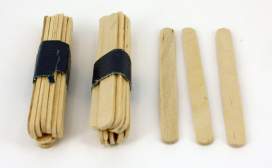Diagnostic questions
Write the numbers 14, 40, and 26 on separate cards. Provide the student with a set of bundles and sticks (iceblock sticks bundled in groups of ten and single sticks).
- Ask the student to count how many sticks there are in a bundle.
- Show the student the card with 14 written on it.
a. Ask the student to read out the number.
b. Ask the student to use the iceblock sticks to show you the number. - Show the student the card with 40 written on it.
a. Ask the student to read out the number.
b. Ask the student to use the iceblock sticks to show you the number. - Show the student the card with 26 written on it.
a. Ask the student to read out the number.
b. Ask the student to use the iceblock sticks to show you the number.
What to notice in the student’s response
Can the student correctly read the numbers? (Listen carefully to ensure that they distinguish clearly between fourteen and forty.) Does the student try to count out the numbers using single sticks? Does the student identify that the digit in the tens place is the number of groups of ten?
Deliberate acts of teaching
 Materials
Materials
- Sticks and bundles
- Simple place value chart: Create two columns, labelled “tens” and “ones”, on an A3 piece of card (portrait orientation). Laminate the card.
- A vertical number strip from 1 to 20, with 1 at the base and 20 at the top
- A hundreds chart
Students who struggle with sequencing sometimes perform better when working with a vertical number strip. The pattern of the “teen numbers” all beginning with 1 is visually clearer when the numbers are presented vertically.
Constructing Teens
Work with the student to relate each number on the vertical number strip to models made using a place value chart and iceblock sticks. Place a transparent yellow counter over the 1 on the vertical number strip and position one stick in the ones column of the place value chart. Move the counter up to 2 and ask the student to add another stick to the ones column of the place value chart. Continue to move the counter up the number strip until you get to 10.
Explain that when the ones column has ten sticks in it, the sticks need to be bundled together and moved to the tens column. Use a rubber band to bundle the set. Ask the student to place the bundle in the tens column. Draw attention to the labels on the columns. Ask the student how many tens there are and how many ones there are. Have them practise reading 10 as “1 ten and no ones”.
Move on to the teen numbers. Ask the student to refer to each number as a number of tens and a number of ones. For example, for 13, the student should say “1 ten and 3 ones”.
Constructing Decades
Repeat the process above, using the decade column of a hundreds chart instead of the number strip. Refer to the “-ty” numbers as numbers of tens with no ones, for example, 40 is 4 tens and no ones.
Extend to two-digit numbers, for example, 34 is 3 tens and 4 ones. Keep emphasising the connection between the way the number is written, its model, and its meaning.
What to do next if the student is stuck
Work on one-to-one counting and on recognising the numbers from 1 to 20.
Initiating home-based activities
Provide students with iceblock sticks and bundles to take home for extra practice. Give the student a list of two-digit numbers and ask them to make them at home with their parents. For additional activities, use Tens in Tens and Ten And Facts in the Families section on www.nzmaths.co.nz.
Next teaching steps back in the classroom
Use place value equipment when developing strategies for addition and subtraction. Provide opportunities for targeted work on teen numbers and the “-ty” numbers.